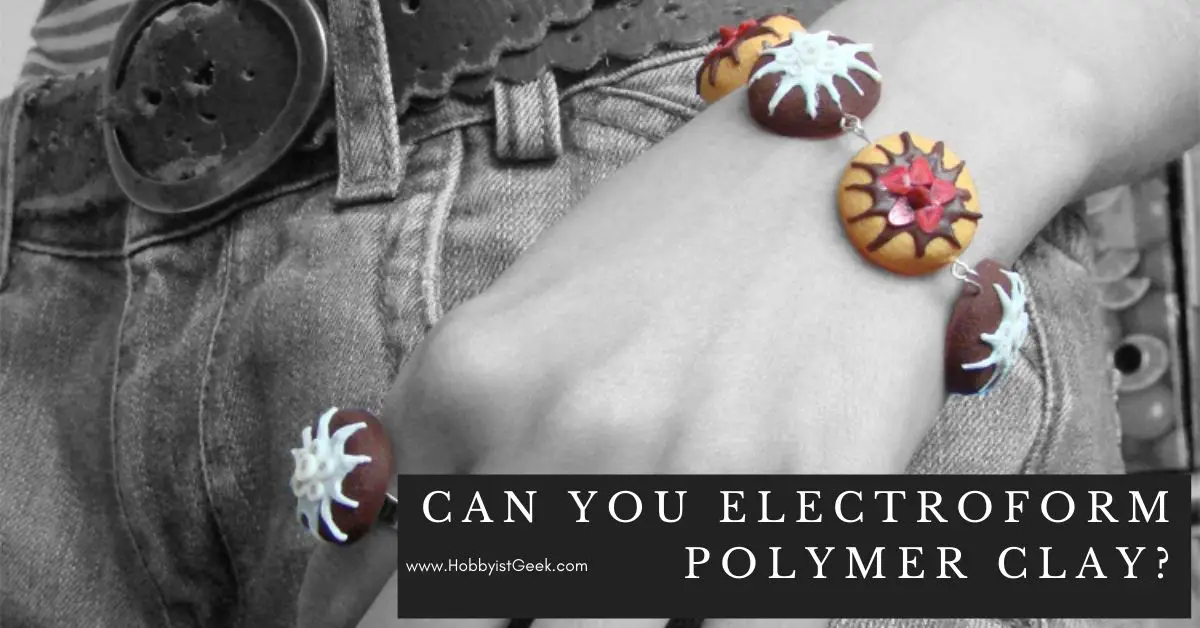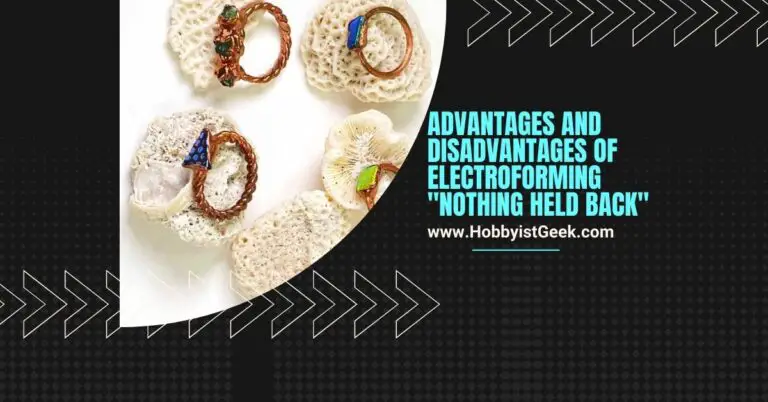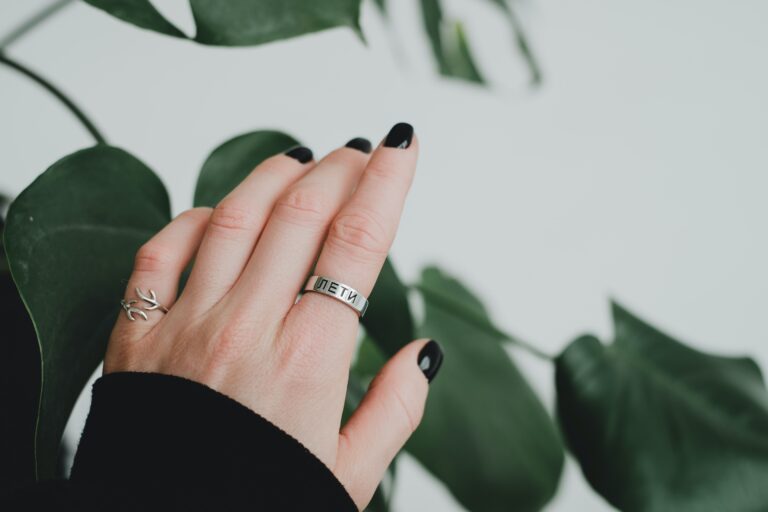Can You Electroform Polymer Clay?
Can You Electroform Polymer Clay?
We, as electroforming artists, are constantly seeking to enhance the artistic freedom that our hobby gives us, therefore we’re exploring different techniques to create pieces to put through the mesmerizing electroforming process.
Previously we’ve discussed using organics from nature and using resin molds to create your own pieces.
Today, we’ll be taking our possibilities a step further, we’re going to look into making our own pieces to electroform, using polymer clay, but can you electroform polymer clay?
Can you electroform polymer clay?
In short, yes you can! In fact, it opens a world of opportunity to us, using polymer clay we can make our own base pieces to electroform.
We can make everything we’d like, such as jewelry for example.
First, we go through the claying process, to create our base piece in polymer clay, after that we continue with the regular electroforming steps, such as conductive painting and sealing!
We’ll be left with unlimited artistic freedom!
In this article, we’ll discuss the ins and outs of using polymer clay in your electroforming projects, what clay to use, how to use it, how to form it, and many more!
Understanding the use of polymer clay enhances your electroforming possibilities dramatically, and it opens up borders to unexplored territories! Let’s jump right into it!
What Is Polymer Clay?
Before we can start creating magnificent pieces of art using polymer clay, we’ll need to take a step back to the basics.
Back to a little course on what Polymer clay even is! In short, polymer clay is a man-made clay that’s very popular among artists and hobbyists!
Because it’s man-made, and not natural, it’s carefully designed to suit our needs as artists, it doesn’t dry on its own and a regular kitchen oven can be used to harden the clay!
This opens up many possibilities to us as hobbyists, or perhaps even as professionals.
We can use polymer clay to mold and form a shape we like, anything in our imagination!
Polymer clays are also available in many different colors and even effects such as glitter or glow in the dark.
This makes creating anything, ranging from jewelry to pottery, much easier and much more effective!
What Polymer Clay Is Best For Jewelry?
Now that we’re familiar with the definition of polymer clay, we can shift our focus to applying this knowledge, and what better way than to start with jewelry!
Jewelry is a popular object to electroform, and polymer clay is a perfect base!
There are many different brands and characteristics within the world of polymer clay though, so which one am I supposed to use when working with jewelry, and how does it all work?
When creating jewelry, you’ll be looking for clay with certain characteristics to help you along the way.
These characteristics include an easy-to-use and soft clay, a solid and durable surface when baked, and most importantly a slightly flexible clay, even after baking.
These final requirements focus on the wearability of your jewelry, after all, you don’t want your beautiful earrings, or other jewelry pieces, to break when wearing them!
Brands that meet our strict criteria are, Sculpey, Fimo professional, and Kato Polyclay.
If you’re a beginner we recommend using Sculpey as it’s the easiest to use out of the three listed, if you’re an expert and you’re looking for lots of control ability and fine details you’re better of using one of the others listed!
Polymer Clay Fall Necklace, Jewelry Tutorial by Katie Oskin at B’sue Boutiques
What Is Liquid Polymer Clay Used For?
As we’ve mentioned before, there are many different brands and types of polymer clay.
Potentially the most unorthodox of all is Liquid Polymer Clay, this is, as the name suggests, polymer clay in liquid form!
When baked, liquid polymer clay behaves like its solid counterparts, but when molding and creating, it’s a whole different beast!
So, this is very cool, but what do we use this for?
Liquid polymer clay is often used as a glue between solid pieces of clay, adding liquid glue between two solid pieces will ensure proper adhesion.
It’ll also create a more flexible band between two pieces, allowing the seam to handle more stress! Liquid clay might be more useful than you might think!
Which Brand Of Polymer Clay Is The Best?
We’ve already briefly mentioned some of the available brands of Polymer Clay on the market, but we can’t say which one is best, as this is obviously a subjective matter of personal preference.
What we can do though, is give you directions as to what the different brands available represent in their products!
To keep things simple, we’ll stick with the brand we’ve previously mentioned, being Sculpey, Fimo Professional, and Kato Polyclay!
If you’re starting out on your journey in the world of polymer clay, Sculpey is the way to go, it’s the most popular brand out there, and for good reason!
It’s as beginner-friendly as it gets, whilst not sacrificing much performance compared to other brands! If you’re further on your journey, then you’re ready to use any of the other brands mentioned,
Fimo Professional or Kato Polyclay, as these brands allow for more detail in your designs, but they might be a little harder to work with!
What Equipment Do I Need?
Now that we’re familiar with the different types and brands of clay available to us, we can start to look into working with Polymer Clay, but for this, we’ll need tools! What equipment do you need when working with polymer clay, and how do you use these tools?
Most tools you’ll need can be found on Amazon for cheap prices.
These items include things like toothpicks to poke holes or apply fine details, or a rolling pin to help flatten pieces of clay!
An unusual, yet indispensable polymer clay tool is a pasta machine, this might sound weird but allow me to explain, a pasta machine can be used to mix clays together or flatten large chunks of clay, they can be bought on Amazon for around $20, be sure to only use it for clay and don’t use it for food after it has come into contact with the clay!
Another tool you’ll find useful when working with polymer clay is a slicing blade, to apply fine details and make sharp incisions into the clay!
All these items can be bought on Amazon, or other online shops, for very low prices! Complete sets regarding Polymer Clay tools can be found here: https://www.amazon.com/s?k=polymer+clay+tools&ref=nb_sb_noss_1
What Is Polymer Clay Made Of?
As we’ve mentioned before, polymer clay, unlike most kinds of clay, is a man-made clay form.
This means that it wasn’t taken straight from nature, we as humans created the polymer clay substance ourselves for our own use!
If it isn’t from nature though, then what is it made of, and can we electroform polymer clay?
Polymer clay is made using a polyvinyl chloride, more commonly known as PVC, base. PVC is a form of plastic used in many appliances throughout the world, you might know it from the so-called “PVC Tubes”! Of course, PVC alone doesn’t make polymer clay just yet, for that we need to add a few more ingredients like resin and fillers, and potentially coloring!
Because Polymer clay is man-made it’s made with our users in mind, making it way more effective than natural clay!
Please pin this Pinterest pin to your Pinterest board.

How Long Does Polymer Clay Stay Conditioned?
If you’ve ever worked with clay before, you’ll know that conditioning, or softening, your clay is an essential step of the process.
If this is the case, you’ll undoubtedly also know the pain of having to work with unconditioned clay, therefore it’s important to know how long polymer clay stays conditioned!
You will be able to store your conditioned polymer clay forever if you do so in a controlled, airtight environment.
Due to the nature of the clay, it will get stiff after a few hours of not being used, to soften it back up, just start working again, the heat and friction caused by your hands will alter the texture of the clay for it to be soft again!
How Should I Store My Polymer Clay?
We’ve already briefly touched on this issue in the previous paragraph, but it is very important to keep your polymer clay in a safe and appropriate environment!
Taking proper care of your materials is an important aspect of electroforming and any art for that matter, and taking care of your polymer clay is no exception to this!
The most important thing to note when storing your polymer clay is the temperature.
Since the curing process starts taking place at 30℃ or 86℉, it’s not unthinkable to have it start curing in the room on a hot day.
If this happens, you won’t be able to use your clay anymore as you’ll find it’s partially hardened and very grainy, and impossible to work with!
To prevent this from happening, we should store our clay in an airtight environment, and if you live in a warm climate in the freezer!
Taking care of your clay, also when you’re not using it, is an important part of the process and it can prevent many issues down the road!
What Is The Difference Between Sculpey and Premo?
We’ve already looked at the different types and brands of polymer clay, but there is one comparison that always seems difficult for people to make, and that is the difference between Sculpey and Primo!
These are similar clay types, yet quite different in practice!
In short, the difference comes down to durability, Sculpey is generally used more for decorative purposes as it’s easy to use and it has an easy-to-print matte finish when baked, which will be useful to add our conductive paint later on.
Premo on the other hand is more usable for everyday objects to be used in daily life, such as jewelry for example, as Premo delivers very strong and durable results, it’s also a little stiffer to work with.
So choose wisely when planning on what clay to use!
Is Sculpey Clay Non-Toxic?
Since polymer clays don’t come from nature, it’s important to examine their contents to see if there are no harmful substances incorporated in the clay!
This can be of significant importance when working with, or around, children for example. In short, is Sculpey clay toxic, or not?
To answer this question, we can be quite short, Sculpey is NOT toxic! It’s perfectly safe to keep around children, and, in small doses, it can even be accidentally ingested!
This also means that no toxic fumes are released during the baking process, so there’s nothing to worry about!
Does Polymer Clay Ruin Your Oven?
As we’ve previously addressed, one of the benefits of working with polymer clay is that the baking process takes place in a regular kitchen oven.
Obviously, this is a huge plus, but can it also be a disadvantage? Can the baking process of polymer clay ruin your regular kitchen oven?
In terms of safety, the answer is, once again, short, no, it doesn’t harm your oven, nor does it harm the food you put in the oven later! Some people report a slight smell in their oven from baking the clay, but this could be due to poor ventilation.
Undoubtedly, some people will have better taste than others, but in general, it should be perfectly fine to use your regular kitchen oven to bake your polymer clay pieces!
What Temperature Do You Bake Polymer Clay?
Now that we’ve established where to bake our clay projects, it’s time to look at how to bake them!
The baking process isn’t too complicated but getting the temperature and timing wrong can ruin your final result!
Therefore, pay close attention to what’s to come, experience will make this whole process easier!
Most clays will come with detailed baking instructions on the packaging, but in general, you’ll be looking at a 15-30-minute bake at 275℉, or 135℃! The baking time will obviously vary based on the size, and primarily the thickness of your design.
Therefore, it’s wise to check the progress multiple times throughout the baking process!
Does Polymer Clay Harden After Baking?
As mentioned previously, polymer clay hardens after the baking process.
The baking process turns the clay from a soft and moldable substance to a solid and rock-hard shape! Depending on the clay you used, you will get different finishing and durability results after baking.
So choose your clay wisely, and pay close attention to the baking process of your piece, to achieve the optimal results!
Can I Mix Different Brands Of Polymer Clay?
We already covered the different brands of Polymer Clay and the different characteristics that their clay comes with.
That raises the question: Can I mix different brands of polymer clay?
This can be useful for a multitude of reasons.
And once again, the answer is rather simple, yes you can! In fact, mixing different brands of Polymer Clay will combine the properties of both clays, meaning you can essentially mix the clay to your liking by combining different clay brands!
Be sure to mix the two clay types properly when applying this technique, as failing to do so can cause unsatisfactory results!
Will Polymer Clay Harden Without Baking?
One of the many strengths of polymer clay is that it always remains soft and moldable unless it’s baked.
The polymer clay doesn’t harden without the baking process, meaning it can be stored for long times and still be used perfectly fine afterward!
How To Electroform Polymer Clay?
Now that we’ve created our beautiful base pieces of polymer clay, it’s time to electroform them! For the most part, this process is familiar to us, start by painting the areas to be electroformed with copper conductive paint.
After that, you can go through the regular steps of placing your piece in the bath and letting the rectifier do its magic!
When working with polymer clay, we can create some interesting effects.
We can do this by, for example, leaving a piece of clay uncovered by the copper to create interesting color schemes! This is where our question, can you electroform polymer clay, is answered!
You’ll be left with beautifully electroformed pieces of polymer clay, the sky is the limit!
Final Thoughts For Can You Electroform Polymer Clay?
So all in all, using polymer clay can open up a world of possibilities for your electroforming career, and the world of polymer clay is an art in itself, we answered the question of, can you electroform polymer clay, with a solid yes!
I hope this article has provided a solid lead to kickstart your polymer claying career, and I hope it’ll help elevate your electroforming projects to the next level!
Thank you for reading, and good luck on your electroforming journey!
Electroforming: The Ultimate Guide Check It Out!
Sources in MLA Format:
“About Polymer Clay – Things You Need to Know & Frequently Asked Questions.” 2wards Polymer Clay, 20 Jan. 2021, 2wardspolymerclay.com.au/polymer-clay-faq/#:~:text=18.,an%20airtight%20and%20cool%20environment.
artist, I’m Sarah —. “Best Polymer Clay for Earrings and Jewelry.” Sarah Maker, 13 Feb. 2021, sarahmaker.com/best-polymer-clay-for-earrings-and-jewelry/#:~:text=Recommendations,and%20specialty%20colors%2C%20try%20Cernit.
“Common Polymer Clay Questions.” Sculpey Blog, 18 Oct. 2018, www.sculpey.com/create/blog/common-polymer-clay-questions/#:~:text=Bake%20%E2%80%94%20You%20only%20need%20a,for%2015%20to%2030%20minutes.
“Common Polymer Clay Questions.” Sculpey Blog, 18 Oct. 2018, www.sculpey.com/create/blog/common-polymer-clay-questions/#:~:text=Polymer%20clay%20is%20a%20manmade,include%20resins%2C%20fillers%20and%20coloring.
DeVoto, Jeanne A. E. “Polymer Clay FAQ: Choosing & Mixing.” Polymer Clay FAQ | Choosing & Mixing, www.jaedworks.com/clayspot/polyclay-faq/mixing.html#:~:text=Can%20I%20mix%20different%20brands,Fimo%2C%20but%20stronger%20than%20Sculpey.
“Electroforming Tutorial – Free Step by Step Guide to Making Copper Ele.” Enchanted Leaves, enchantedleaves.com/pages/electroforming-tutorial-free-step-by-step-guide-to-making-copper-electroformed-jewelry-learn-how-to-electroform.
“Forum Topic – Will Polymer Clay Ruin My Oven??” Etsy, www.etsy.com/forums_thread.php?thread_id=5486086&page=2.
Jekyll1911. “Quick Answer: What Is The Difference Between Sculpey III And Premo?” Ceramics, 18 Feb. 2020, expandusceramics.com/qa/what-is-the-difference-between-sculpey-iii-and-premo.html.
“Liquid Polymer Clay: Clay Glue.” Sculpey, www.sculpey.com/products/liquid-sculpey-liquid-polymer-clay.
Polymer Clay Superstore. “FAQs.” Polymer Clay Superstore, polymerclaysuperstore.com/pages/faqs#:~:text=Sculpey%20III%20is%20easy%20to,crack%20when%20baking%20large%20pieces.
Polymer Clay Superstore. “Polymer Clay Information For Beginners.” Polymer Clay Superstore, polymerclaysuperstore.com/pages/polymer-clay-for-beginners.
“Polymer Clay Tools for Beginners.” Jessama Tutorials, www.jessamatutorials.com/clay-tools.html.
- Electroforming Conductive Paint, Where To Buy It, And How To Make It – The Ultimate Guide - April 24, 2021
- Copper Electroforming Solution Recipe - April 20, 2021
- Can You Electroform Polymer Clay? - April 13, 2021







